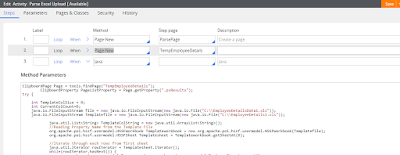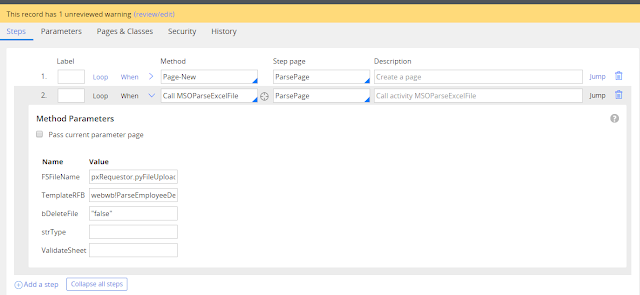open Source BPM Tools:
In the Previous post we saw about the need for BPM tools. In this Post we will see brief about open source bpm tools in market.
Links for downloading are given here, you can try all the available tools and by analysing to find out which one suits for your business.
Bonita
Bonita BPM improves business operations by connecting people, processes, and information systems into easily managed applications. Use Bonita Studio to map the organization, define the data structure, build the user interface, and create actionable reports. Bonita Portal creates a central location to perform tasks, monitor case completion, search for information, and collaborate with peers.
It can be used to draw work flows with BPMN standards. Its can also used to connect processes to other pieces of the information system (such as messaging, enterprise resource planning, enterprise content management, and databases) in order to generate an autonomous business application accessible as a web form. Its java based application. and UI ie portal is based on Angular JS.
offical link:
http://www.bonitasoft.com/
and download link at:
http://www.bonitasoft.com/downloads-v2
---------------------------------------------------
Talend:
Talend’s BPM products enable managers, business analysts, developers and end users to model current processes, collaborate on improvements, and rapidly create and optimize process-driven solutions in minutes. Talend combines three solutions in one: an innovative process modeler, a
powerful BPM and workflow engine, and a breakthrough user interface for the creation of forms. You can create human interactive or process-based applications, and automate and optimize business processes in a single day.
Talend Source link:
https://www.talend.com
it can be downloaded at :
https://www.talend.com/download
and can see the List of Customers using :
https://www.talend.com/customers
Talends Used for Data Processing for Data Analysis:
Data is everywhere but more often than not it is incomplete, out of date or worst incorrect. You rely on IT or other colleagues to get access to the data and spend hours with tools like Excel to fix it to meet your needs.
With Talend Data Preparation, meet the demands faster and unlock the power of your data. It is a self-service data prep tool so easy that anyone can create clean, relevant data in minutes. With its fully functional data preparation capabilities, Talend Data Preparation auto-discovers the meaning of your data, highlights invalid values and suggests best actions to fix the data. Then export to Excel, Tableau or other targets for other analysis.
---------------------------------------------------
Activiti:
Activiti is a light-weight workflow and Business Process Management (BPM) Platform targeted at business people, developers and system admins. Its core is a super-fast and rock-solid BPMN 2 process engine for Java. It’s open-source and distributed under the Apache license. Activiti runs in
any Java application, on a server, on a cluster or in the cloud. It integrates perfectly with Spring, it is extremely lightweight and based on simple concepts.
Activiti supports all aspects of Business Process Management (BPM) in the full context of software development. This includes non technical aspects like analysis, modeling and optimizing business processes as well as technical aspects of creating software support for business processes. Activiti recognizes that BPM as a management discipline is a completely different aspect then BPM as software engineering.
Activiti’s primary purpose and focus is to implement the general purpose process language BPMN 2.0. And there is no single process language that can cover all the use cases well. In many cases a custom dedicated process language makes sense. So at the core, Activiti has the Process Virtual
Machine architecture. That means that any custom process language can be build on top of it.
Activiti Source Link:
http://activiti.org/index.html - for sample trails
and for entriprise level application trials are available at:
https://www.alfresco.com
and can see the list of customers using:
https://www.alfresco.com/partners
---------------------------------------------------
Camunda:
Camunda is an open source platform for workflow and business process automation. It executes BPMN 2.0, is very light-weight and scales very well.
Camunda is written in Java and a perfect match for Java EE and Spring while providing a powerful REST API and script language support. Camunda BPM can be used for system integration workflows as well as for human workflow and case management.
You can add camunda to your Java application as a library. You can also use it as a container service in Tomcat, JBoss etc., so it can be used by multiple applications which can be redeployed without shutting down the process engine. Some of the biggest companies in the world and most trusted public institutions rely on camunda.
Camunda BPM is an original commercial workflow management system of in Berlin based company Camunda which on Activiti , a free workflow management system, built. Camunda was next Alfresco one of the biggest supporters for Activiti.
official link:
https://camunda.org/
and to download
https://camunda.org/download/
---------------------------------------------------
Intalio:
Intalio bpms provides a comprehensive enterprise-class platform to design, deploy, and manage the most complex business processes; over 1000 organizations world-wide in all industries rely on the technology to manage their mission-critical business processes. Intalio bpms features an intuitive and powerful visual designer and a reliable high-performance process execution server. It also includes enterprise-level capabilities such as business activity and metrics monitoring, business rules and decision management, document management, mobility support, and system integration tools and portals.
Integration with different Form and UI technologies: Integrate processes with the user interface technologies and forms of your choice and similar to other BPM Tools, Business rules can be edited on the fly and lot of other features are available.
Official Link:
http://www.intalio.com/
To download:
http://www.intalio.com/resources/downloads/
---------------------------------------------------
jBPM:
jBPM is a flexible Business Process Management (BPM) Suite. It makes the bridge between business analysts and developers. Traditional BPM engines have a focus that is limited to non-technical people only. jBPM has a dual focus: it offers process management features in a way that both business users and developers like it. The core of jBPM is a light-weight, extensible workflow engine written in pure Java that allows you to execute business processes using the latest BPMN 2.0 specification. It can run in any Java environment, embedded in your application or as a service.
Offical site:
http://www.jbpm.org/
Download at:
https://download.jboss.org/jbpm/release/6.4.0.Final/jbpm-6.4.0.Final-installer-full.zip
--------------------------------------------------
jSonic:
jSonic BPM suite enables enterprise owners to align business processes with the dynamic market conditions, statutory compliances and, customer and partner requirements. It is a comprehensive solution that improves the bottom line of organization by increasing process efficiency, optimizing resource utilization and automating human workflow system.
jSonic BPM suite, the Open Source BPM Software offers an all-encompassing solution covering process designing, modeling, executing, automating and monitoring as per the business needs and wants. The major components of the suite include Process Management, Workflow Management and the Interface Designer.
---------------------------------------------------
Orchestra:
Orchestra is a complete solution to handle long-running, service oriented processes. It provides out of the box orchestration functionalities to handle complex business processes. It is based on the OASIS standard BPEL (Business Process Execution Language). Orchestra’s objectives:
- Improvement and control of processes
- Services interaction
- Productivity and agility of the company
- Orchestra is fully Open Source and is downloadable under the LGPL License.
----------------------------------------------------
ProcessMaker:
ProcessMaker is a cost effective and easy to use open source business process management (BPM) or workflow software application. Workflow software such as ProcessMaker can assist organizations of any size with designing, automating and deploying business processes or workflows of various kinds.
ProcessMaker workflow software features an extensive toolbox which provides the ability to easily create digital forms and map out fully functioning workflows. The software is completely web based and accessed via any web browser, making it simple to manage and coordinate workflows throughout an entire organization – including user groups and departments. ProcessMaker workflow software can also interact with other applications and systems such as ERP, business intelligence, CRM and document management.
ProcessMaker is extremely efficient, lightweight and has one of the lowest overheads of any workflow software in the industry. With the additional benefit of it being open source, ProcessMaker Enterprise clients can take advantage of a fully supported, high quality BPM suite.
Customers on 5 continents, through 17 different languages and across a variety of industries including manufacturing, telecommunications, finance and government, healthcare and education are using ProcessMaker workflow software.
Official site:
http://www.processmaker.com/
-----------------------------------------------------
Red Hat JBoss BPM:
Red Hat JBoss BPM Suite is the JBoss platform for Business Process Management (BPM). It enables enterprise business and IT users to document, simulate, manage, automate and monitor business processes and policies. It is designed to empower business and IT users to collaborate more effectively, so business applications can be changed more easily and quickly. Create, test, deploy and monitor BPMN2-based business processes to optimize enterprise workflows and automate critical processes. Includes all the business rules and event processing capabilities of Red Hat JBoss BRMS. Easily create real-time dashboards to monitor key performance indicators for running processes and activities.












